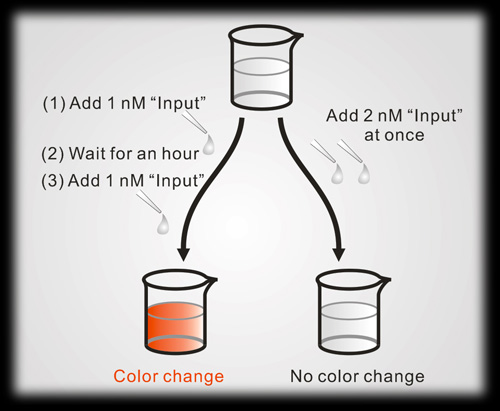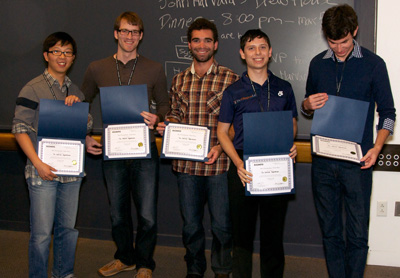 Illustration by the Hook 'Em Hybridizers.
Illustration by the Hook 'Em Hybridizers. The Hook 'Em Hybridizers accept their award at the BIOMOD competition in November. Photo credit Wyss Institute and Dennis O’Reilly.
The Hook 'Em Hybridizers accept their award at the BIOMOD competition in November. Photo credit Wyss Institute and Dennis O’Reilly.
In the world of molecules, DNA is perhaps the ultimate computer processor. It stores, processes and transfers information as it builds and operates living cells and organisms.
And teams of scientists, such as the Hook ‘Em Hybridizers, are figuring out how to exploit those properties of DNA to build new computational systems, just as engineers use silicon and wires.
The Hybridizers, a team of undergraduates, supervised by post-docs and faculty in the Center for Systems & Synthetic Biology in the College of Natural Sciences, recently traveled on Nov. 5 to Harvard University to compete in BIOMOD, a worldwide biomolecular design competition.
Their entry was a molecular counter made out of DNA fragments that can count the pulses of molecules that are added into a liquid solution
The team placed third in the Best Presentation category out of 21 teams, some from as far as Peru, Denmark, India and Japan, and received a Gold Award, along with nine other teams.
“BIOMOD was an extension of the students’ research,” said Xi Chen, the postdoctoral researcher mentoring the team, which was formed in April 2011. “It is an event to cultivate creativity in young scientists worldwide. It gives undergraduates a chance to experience science with a passion and be able to build whatever they can dream up.”
“We use DNA, a natural compound, to do something rather unnatural - count,” Chen said. “DNA is the best tool for this job because of its ability to transfer information.”
The Hybridizers’ system counts the pulses of molecules added into a beaker filled with different DNA fragments in solution. The fragments use their natural ability to transfer information to sense the addition of a molecule to the solution, but the counter ignores the amount or concentration added during the addition.
The team aimed to engineer the DNA system so that it would fluoresce if the input molecule is injected once into the sample and then again after a one-hour delay. However, if two additions are combined and added together, there would be no resulting color change (see illustration).
Ben Braun, one of the four undergraduates on the team who has been doing similar research since his freshman year, said that the idea of a counter system could one day be used in smart drugs after much more research. A drug using this type of counter could remain in the body for a certain number of specific events, for example insulin surges after one eats.
“A drug could be designed to remain in a human's circulation system until six insulin pulses, corresponding to six meals or approximately two days, are detected,” said Braun, who also designed the large amount of simulation software used in the research.
“Perhaps one day we will stumble upon a molecular system that has the ability to learn or remember any foreign agents it encounters, acting like a mini immune system,” he said.

















Comments 1
Pretty nice post. I simply stumbled upon your weblog and wanted to say that I have truly enjoyed browsing your weblog posts. After all I will be subscribing to your feed and I am hoping you write once more very soon!